AIR NEW ZEALAND.
VerifiedAdded on 2022/12/30
|16
|4042
|38
AI Summary
proper citation with enough references
Contribute Materials
Your contribution can guide someone’s learning journey. Share your
documents today.
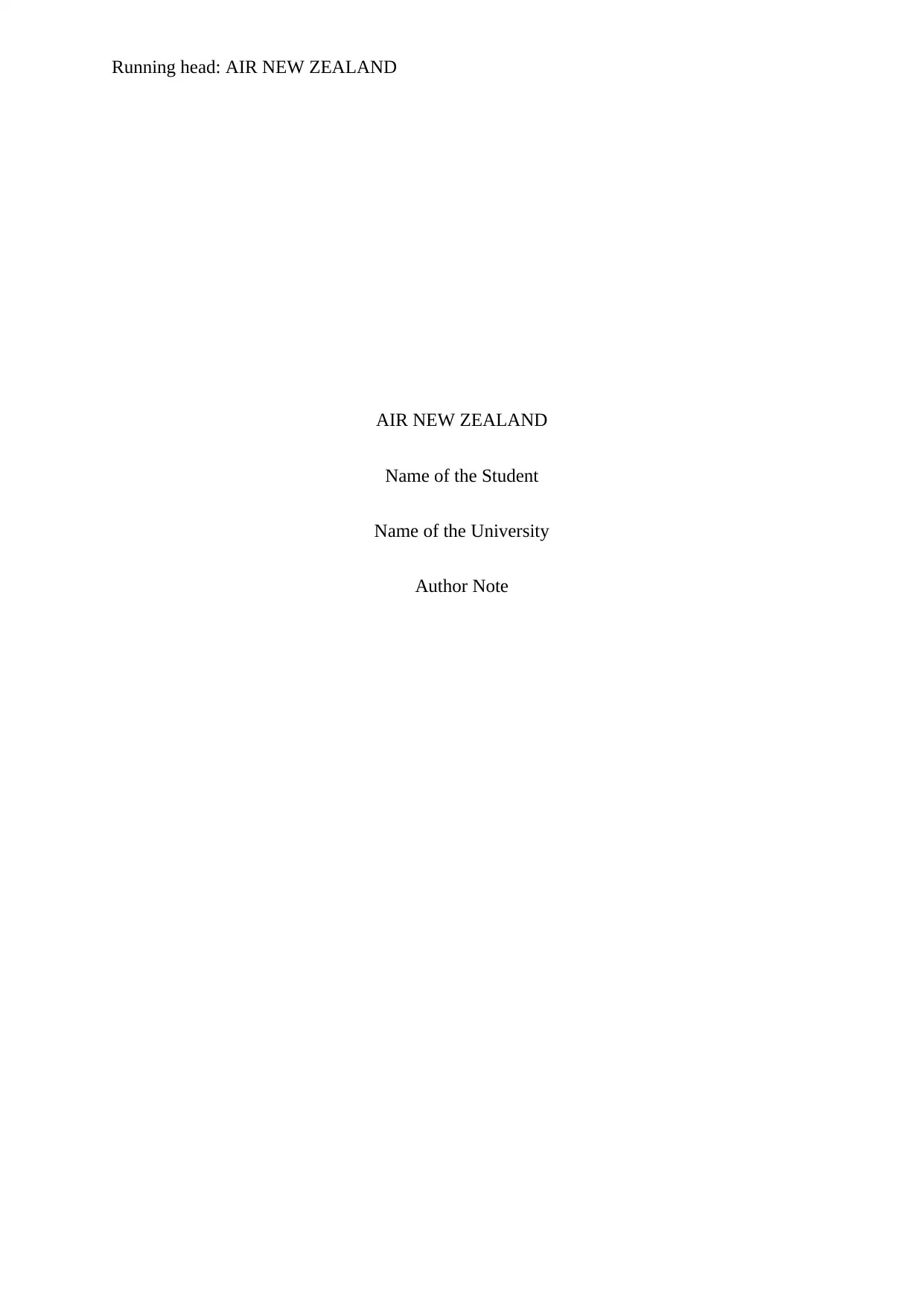
Running head: AIR NEW ZEALAND
AIR NEW ZEALAND
Name of the Student
Name of the University
Author Note
AIR NEW ZEALAND
Name of the Student
Name of the University
Author Note
Secure Best Marks with AI Grader
Need help grading? Try our AI Grader for instant feedback on your assignments.
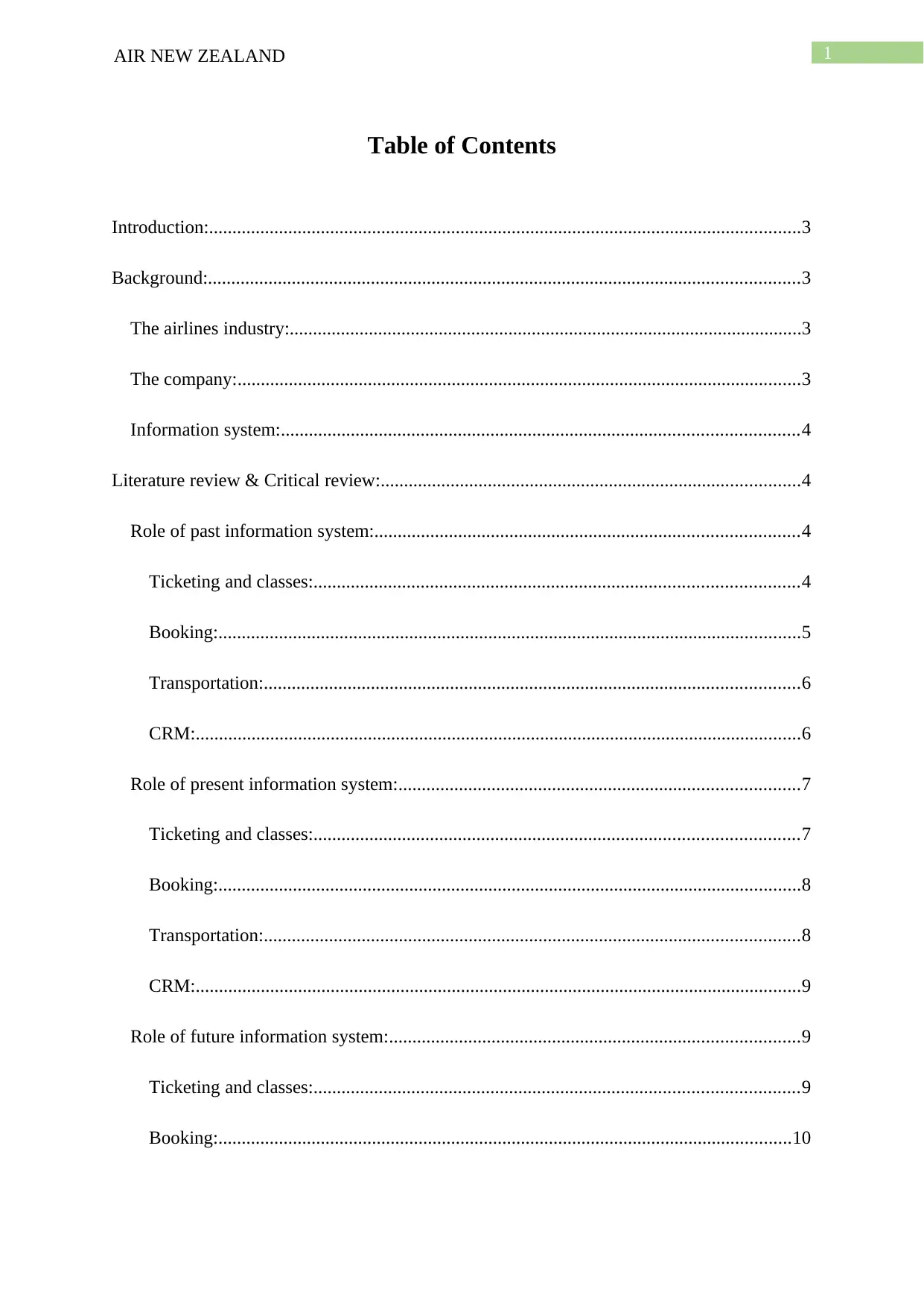
AIR NEW ZEALAND 1
Table of Contents
Introduction:...............................................................................................................................3
Background:...............................................................................................................................3
The airlines industry:..............................................................................................................3
The company:.........................................................................................................................3
Information system:...............................................................................................................4
Literature review & Critical review:..........................................................................................4
Role of past information system:...........................................................................................4
Ticketing and classes:........................................................................................................4
Booking:.............................................................................................................................5
Transportation:...................................................................................................................6
CRM:..................................................................................................................................6
Role of present information system:......................................................................................7
Ticketing and classes:........................................................................................................7
Booking:.............................................................................................................................8
Transportation:...................................................................................................................8
CRM:..................................................................................................................................9
Role of future information system:........................................................................................9
Ticketing and classes:........................................................................................................9
Booking:...........................................................................................................................10
Table of Contents
Introduction:...............................................................................................................................3
Background:...............................................................................................................................3
The airlines industry:..............................................................................................................3
The company:.........................................................................................................................3
Information system:...............................................................................................................4
Literature review & Critical review:..........................................................................................4
Role of past information system:...........................................................................................4
Ticketing and classes:........................................................................................................4
Booking:.............................................................................................................................5
Transportation:...................................................................................................................6
CRM:..................................................................................................................................6
Role of present information system:......................................................................................7
Ticketing and classes:........................................................................................................7
Booking:.............................................................................................................................8
Transportation:...................................................................................................................8
CRM:..................................................................................................................................9
Role of future information system:........................................................................................9
Ticketing and classes:........................................................................................................9
Booking:...........................................................................................................................10
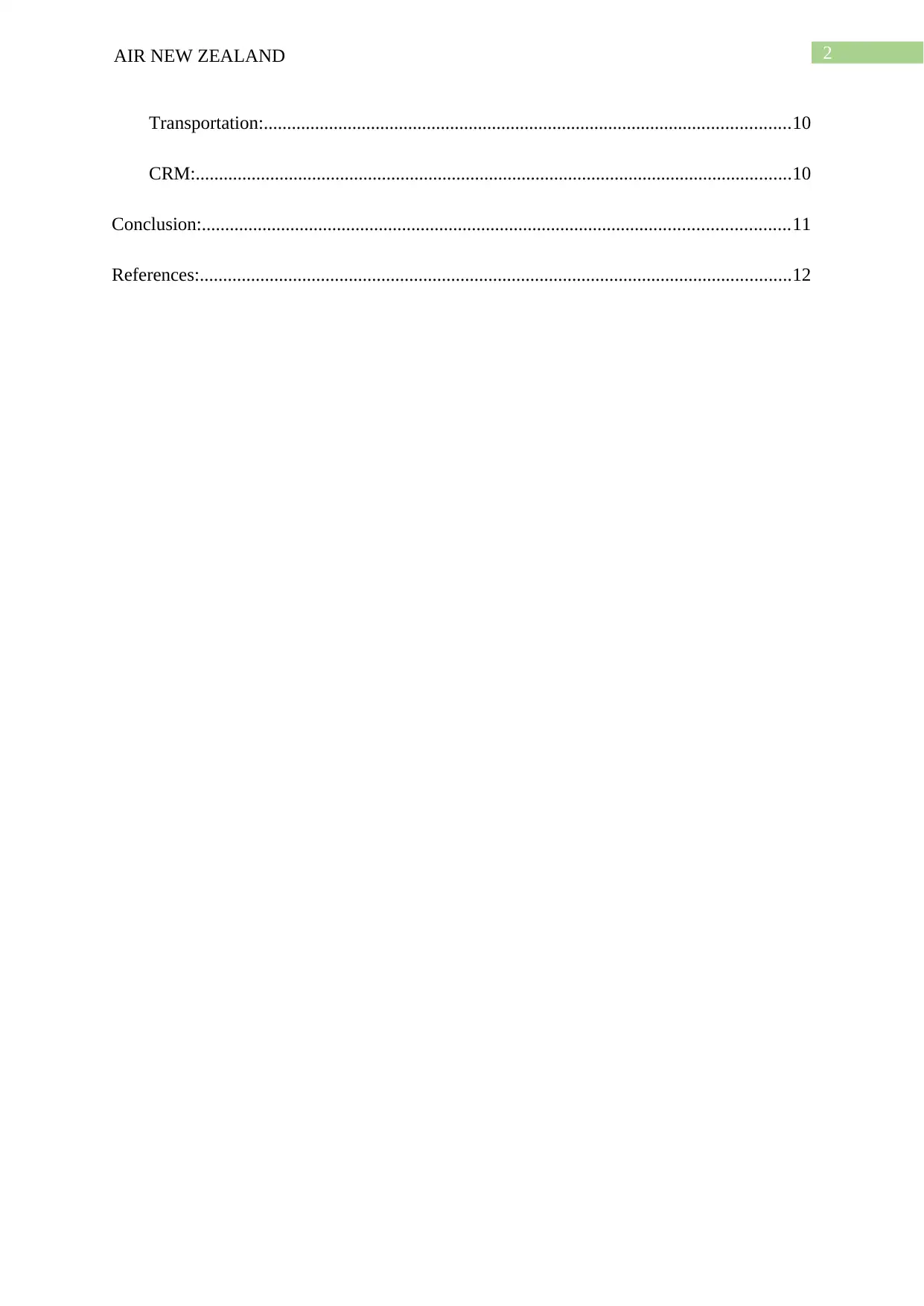
2AIR NEW ZEALAND
Transportation:.................................................................................................................10
CRM:................................................................................................................................10
Conclusion:..............................................................................................................................11
References:...............................................................................................................................12
Transportation:.................................................................................................................10
CRM:................................................................................................................................10
Conclusion:..............................................................................................................................11
References:...............................................................................................................................12
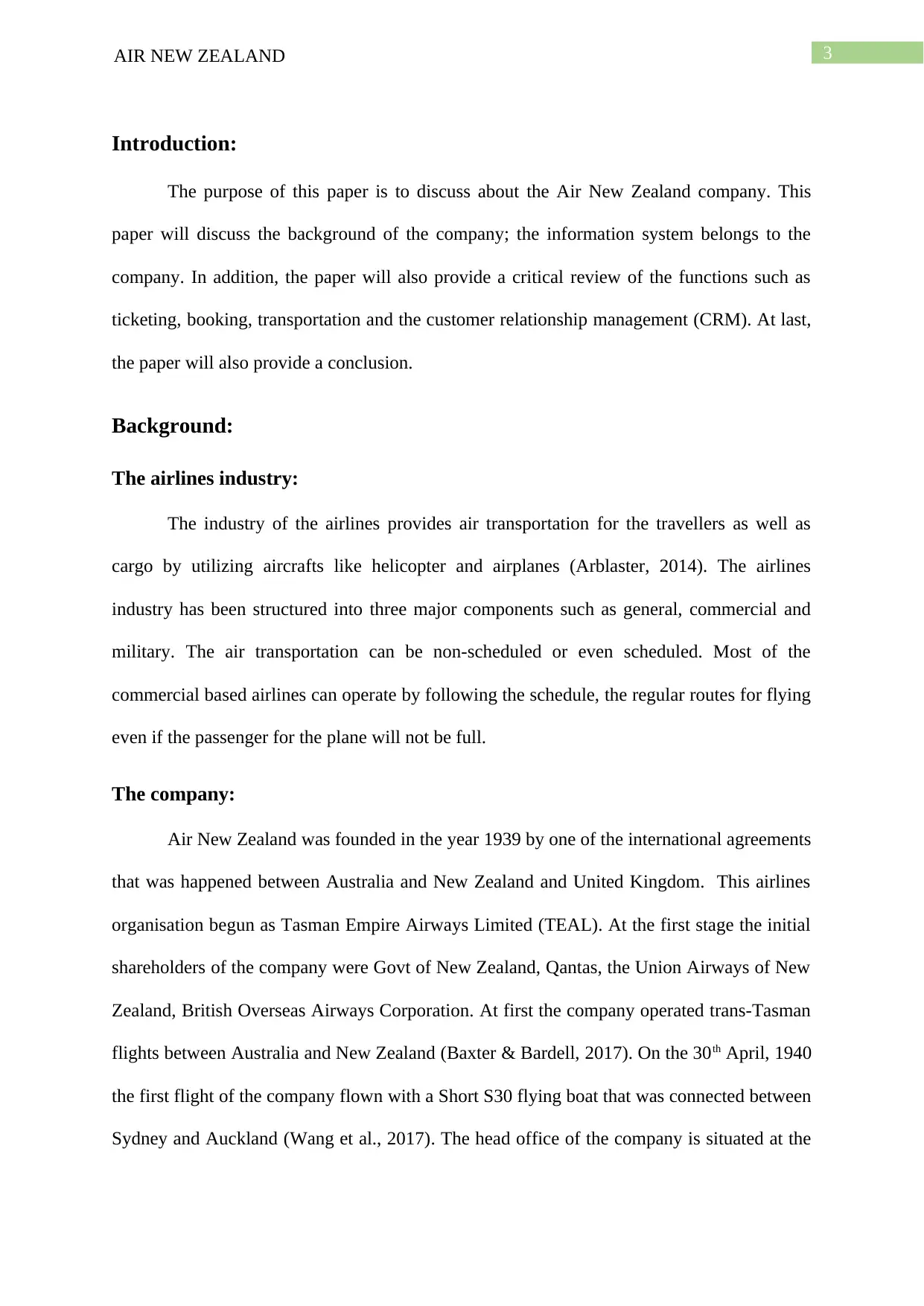
3AIR NEW ZEALAND
Introduction:
The purpose of this paper is to discuss about the Air New Zealand company. This
paper will discuss the background of the company; the information system belongs to the
company. In addition, the paper will also provide a critical review of the functions such as
ticketing, booking, transportation and the customer relationship management (CRM). At last,
the paper will also provide a conclusion.
Background:
The airlines industry:
The industry of the airlines provides air transportation for the travellers as well as
cargo by utilizing aircrafts like helicopter and airplanes (Arblaster, 2014). The airlines
industry has been structured into three major components such as general, commercial and
military. The air transportation can be non-scheduled or even scheduled. Most of the
commercial based airlines can operate by following the schedule, the regular routes for flying
even if the passenger for the plane will not be full.
The company:
Air New Zealand was founded in the year 1939 by one of the international agreements
that was happened between Australia and New Zealand and United Kingdom. This airlines
organisation begun as Tasman Empire Airways Limited (TEAL). At the first stage the initial
shareholders of the company were Govt of New Zealand, Qantas, the Union Airways of New
Zealand, British Overseas Airways Corporation. At first the company operated trans-Tasman
flights between Australia and New Zealand (Baxter & Bardell, 2017). On the 30th April, 1940
the first flight of the company flown with a Short S30 flying boat that was connected between
Sydney and Auckland (Wang et al., 2017). The head office of the company is situated at the
Introduction:
The purpose of this paper is to discuss about the Air New Zealand company. This
paper will discuss the background of the company; the information system belongs to the
company. In addition, the paper will also provide a critical review of the functions such as
ticketing, booking, transportation and the customer relationship management (CRM). At last,
the paper will also provide a conclusion.
Background:
The airlines industry:
The industry of the airlines provides air transportation for the travellers as well as
cargo by utilizing aircrafts like helicopter and airplanes (Arblaster, 2014). The airlines
industry has been structured into three major components such as general, commercial and
military. The air transportation can be non-scheduled or even scheduled. Most of the
commercial based airlines can operate by following the schedule, the regular routes for flying
even if the passenger for the plane will not be full.
The company:
Air New Zealand was founded in the year 1939 by one of the international agreements
that was happened between Australia and New Zealand and United Kingdom. This airlines
organisation begun as Tasman Empire Airways Limited (TEAL). At the first stage the initial
shareholders of the company were Govt of New Zealand, Qantas, the Union Airways of New
Zealand, British Overseas Airways Corporation. At first the company operated trans-Tasman
flights between Australia and New Zealand (Baxter & Bardell, 2017). On the 30th April, 1940
the first flight of the company flown with a Short S30 flying boat that was connected between
Sydney and Auckland (Wang et al., 2017). The head office of the company is situated at the
Secure Best Marks with AI Grader
Need help grading? Try our AI Grader for instant feedback on your assignments.
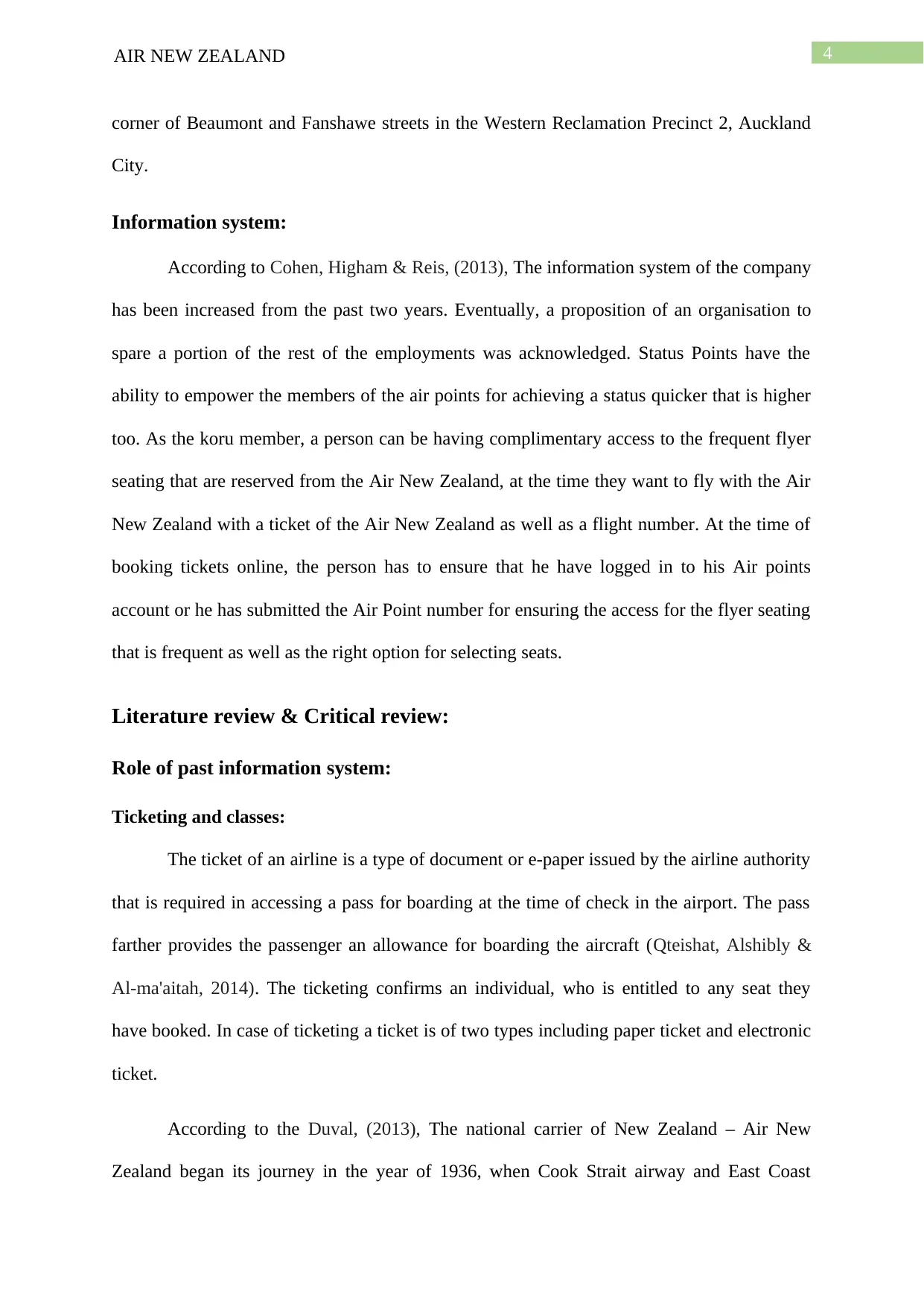
4AIR NEW ZEALAND
corner of Beaumont and Fanshawe streets in the Western Reclamation Precinct 2, Auckland
City.
Information system:
According to Cohen, Higham & Reis, (2013), The information system of the company
has been increased from the past two years. Eventually, a proposition of an organisation to
spare a portion of the rest of the employments was acknowledged. Status Points have the
ability to empower the members of the air points for achieving a status quicker that is higher
too. As the koru member, a person can be having complimentary access to the frequent flyer
seating that are reserved from the Air New Zealand, at the time they want to fly with the Air
New Zealand with a ticket of the Air New Zealand as well as a flight number. At the time of
booking tickets online, the person has to ensure that he have logged in to his Air points
account or he has submitted the Air Point number for ensuring the access for the flyer seating
that is frequent as well as the right option for selecting seats.
Literature review & Critical review:
Role of past information system:
Ticketing and classes:
The ticket of an airline is a type of document or e-paper issued by the airline authority
that is required in accessing a pass for boarding at the time of check in the airport. The pass
farther provides the passenger an allowance for boarding the aircraft (Qteishat, Alshibly &
Al-ma'aitah, 2014). The ticketing confirms an individual, who is entitled to any seat they
have booked. In case of ticketing a ticket is of two types including paper ticket and electronic
ticket.
According to the Duval, (2013), The national carrier of New Zealand – Air New
Zealand began its journey in the year of 1936, when Cook Strait airway and East Coast
corner of Beaumont and Fanshawe streets in the Western Reclamation Precinct 2, Auckland
City.
Information system:
According to Cohen, Higham & Reis, (2013), The information system of the company
has been increased from the past two years. Eventually, a proposition of an organisation to
spare a portion of the rest of the employments was acknowledged. Status Points have the
ability to empower the members of the air points for achieving a status quicker that is higher
too. As the koru member, a person can be having complimentary access to the frequent flyer
seating that are reserved from the Air New Zealand, at the time they want to fly with the Air
New Zealand with a ticket of the Air New Zealand as well as a flight number. At the time of
booking tickets online, the person has to ensure that he have logged in to his Air points
account or he has submitted the Air Point number for ensuring the access for the flyer seating
that is frequent as well as the right option for selecting seats.
Literature review & Critical review:
Role of past information system:
Ticketing and classes:
The ticket of an airline is a type of document or e-paper issued by the airline authority
that is required in accessing a pass for boarding at the time of check in the airport. The pass
farther provides the passenger an allowance for boarding the aircraft (Qteishat, Alshibly &
Al-ma'aitah, 2014). The ticketing confirms an individual, who is entitled to any seat they
have booked. In case of ticketing a ticket is of two types including paper ticket and electronic
ticket.
According to the Duval, (2013), The national carrier of New Zealand – Air New
Zealand began its journey in the year of 1936, when Cook Strait airway and East Coast
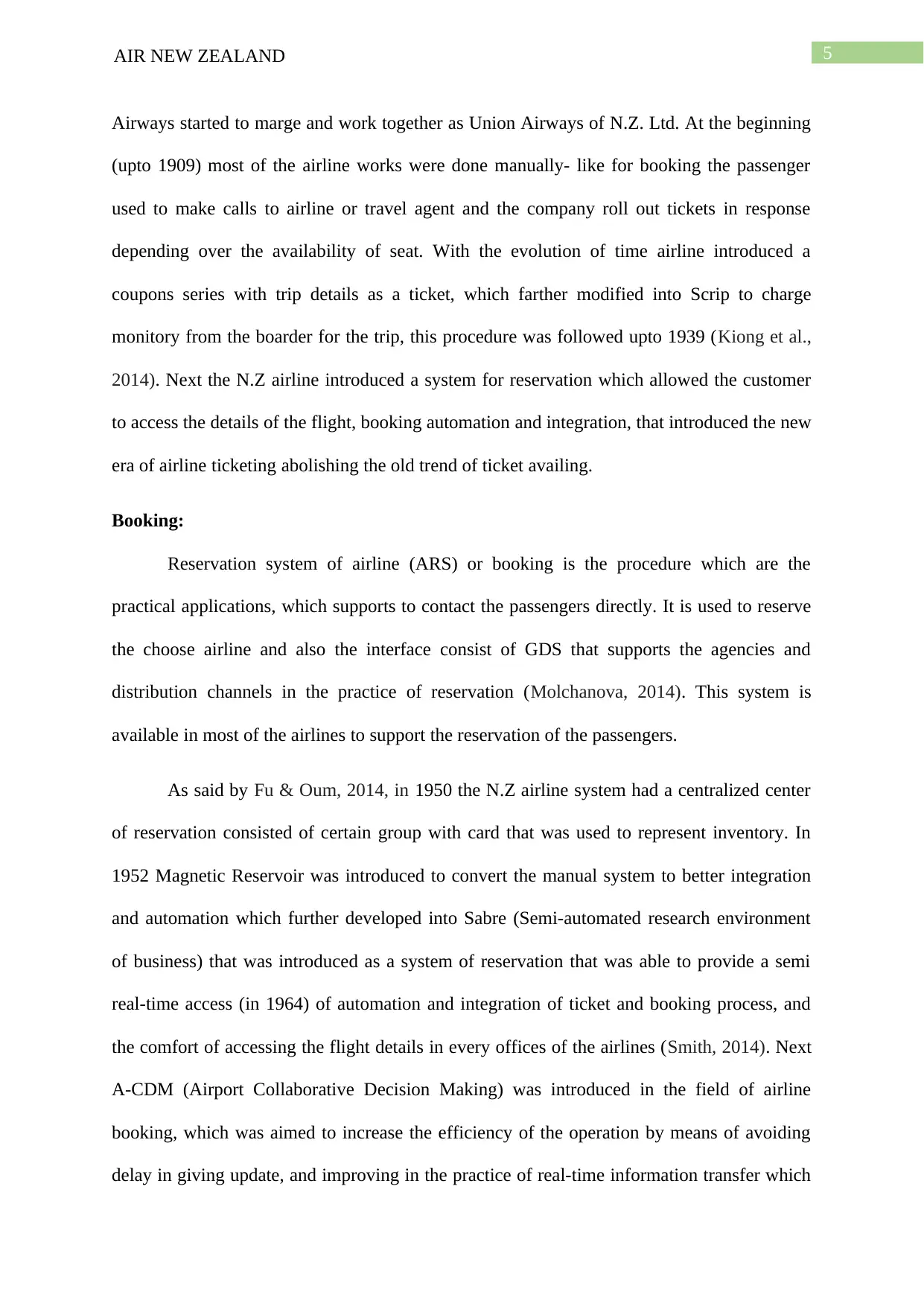
5AIR NEW ZEALAND
Airways started to marge and work together as Union Airways of N.Z. Ltd. At the beginning
(upto 1909) most of the airline works were done manually- like for booking the passenger
used to make calls to airline or travel agent and the company roll out tickets in response
depending over the availability of seat. With the evolution of time airline introduced a
coupons series with trip details as a ticket, which farther modified into Scrip to charge
monitory from the boarder for the trip, this procedure was followed upto 1939 (Kiong et al.,
2014). Next the N.Z airline introduced a system for reservation which allowed the customer
to access the details of the flight, booking automation and integration, that introduced the new
era of airline ticketing abolishing the old trend of ticket availing.
Booking:
Reservation system of airline (ARS) or booking is the procedure which are the
practical applications, which supports to contact the passengers directly. It is used to reserve
the choose airline and also the interface consist of GDS that supports the agencies and
distribution channels in the practice of reservation (Molchanova, 2014). This system is
available in most of the airlines to support the reservation of the passengers.
As said by Fu & Oum, 2014, in 1950 the N.Z airline system had a centralized center
of reservation consisted of certain group with card that was used to represent inventory. In
1952 Magnetic Reservoir was introduced to convert the manual system to better integration
and automation which further developed into Sabre (Semi-automated research environment
of business) that was introduced as a system of reservation that was able to provide a semi
real-time access (in 1964) of automation and integration of ticket and booking process, and
the comfort of accessing the flight details in every offices of the airlines (Smith, 2014). Next
A-CDM (Airport Collaborative Decision Making) was introduced in the field of airline
booking, which was aimed to increase the efficiency of the operation by means of avoiding
delay in giving update, and improving in the practice of real-time information transfer which
Airways started to marge and work together as Union Airways of N.Z. Ltd. At the beginning
(upto 1909) most of the airline works were done manually- like for booking the passenger
used to make calls to airline or travel agent and the company roll out tickets in response
depending over the availability of seat. With the evolution of time airline introduced a
coupons series with trip details as a ticket, which farther modified into Scrip to charge
monitory from the boarder for the trip, this procedure was followed upto 1939 (Kiong et al.,
2014). Next the N.Z airline introduced a system for reservation which allowed the customer
to access the details of the flight, booking automation and integration, that introduced the new
era of airline ticketing abolishing the old trend of ticket availing.
Booking:
Reservation system of airline (ARS) or booking is the procedure which are the
practical applications, which supports to contact the passengers directly. It is used to reserve
the choose airline and also the interface consist of GDS that supports the agencies and
distribution channels in the practice of reservation (Molchanova, 2014). This system is
available in most of the airlines to support the reservation of the passengers.
As said by Fu & Oum, 2014, in 1950 the N.Z airline system had a centralized center
of reservation consisted of certain group with card that was used to represent inventory. In
1952 Magnetic Reservoir was introduced to convert the manual system to better integration
and automation which further developed into Sabre (Semi-automated research environment
of business) that was introduced as a system of reservation that was able to provide a semi
real-time access (in 1964) of automation and integration of ticket and booking process, and
the comfort of accessing the flight details in every offices of the airlines (Smith, 2014). Next
A-CDM (Airport Collaborative Decision Making) was introduced in the field of airline
booking, which was aimed to increase the efficiency of the operation by means of avoiding
delay in giving update, and improving in the practice of real-time information transfer which
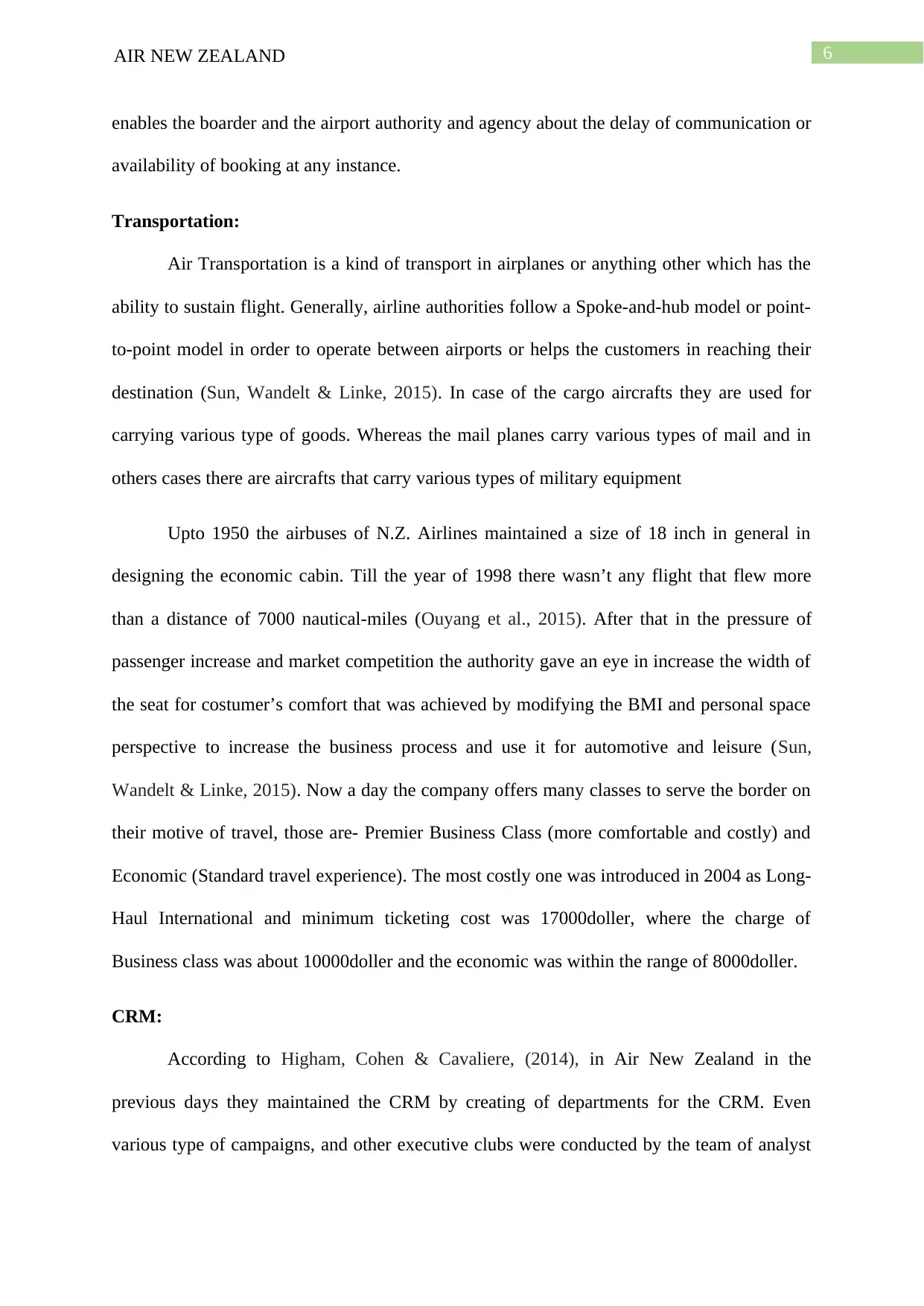
6AIR NEW ZEALAND
enables the boarder and the airport authority and agency about the delay of communication or
availability of booking at any instance.
Transportation:
Air Transportation is a kind of transport in airplanes or anything other which has the
ability to sustain flight. Generally, airline authorities follow a Spoke-and-hub model or point-
to-point model in order to operate between airports or helps the customers in reaching their
destination (Sun, Wandelt & Linke, 2015). In case of the cargo aircrafts they are used for
carrying various type of goods. Whereas the mail planes carry various types of mail and in
others cases there are aircrafts that carry various types of military equipment
Upto 1950 the airbuses of N.Z. Airlines maintained a size of 18 inch in general in
designing the economic cabin. Till the year of 1998 there wasn’t any flight that flew more
than a distance of 7000 nautical-miles (Ouyang et al., 2015). After that in the pressure of
passenger increase and market competition the authority gave an eye in increase the width of
the seat for costumer’s comfort that was achieved by modifying the BMI and personal space
perspective to increase the business process and use it for automotive and leisure (Sun,
Wandelt & Linke, 2015). Now a day the company offers many classes to serve the border on
their motive of travel, those are- Premier Business Class (more comfortable and costly) and
Economic (Standard travel experience). The most costly one was introduced in 2004 as Long-
Haul International and minimum ticketing cost was 17000doller, where the charge of
Business class was about 10000doller and the economic was within the range of 8000doller.
CRM:
According to Higham, Cohen & Cavaliere, (2014), in Air New Zealand in the
previous days they maintained the CRM by creating of departments for the CRM. Even
various type of campaigns, and other executive clubs were conducted by the team of analyst
enables the boarder and the airport authority and agency about the delay of communication or
availability of booking at any instance.
Transportation:
Air Transportation is a kind of transport in airplanes or anything other which has the
ability to sustain flight. Generally, airline authorities follow a Spoke-and-hub model or point-
to-point model in order to operate between airports or helps the customers in reaching their
destination (Sun, Wandelt & Linke, 2015). In case of the cargo aircrafts they are used for
carrying various type of goods. Whereas the mail planes carry various types of mail and in
others cases there are aircrafts that carry various types of military equipment
Upto 1950 the airbuses of N.Z. Airlines maintained a size of 18 inch in general in
designing the economic cabin. Till the year of 1998 there wasn’t any flight that flew more
than a distance of 7000 nautical-miles (Ouyang et al., 2015). After that in the pressure of
passenger increase and market competition the authority gave an eye in increase the width of
the seat for costumer’s comfort that was achieved by modifying the BMI and personal space
perspective to increase the business process and use it for automotive and leisure (Sun,
Wandelt & Linke, 2015). Now a day the company offers many classes to serve the border on
their motive of travel, those are- Premier Business Class (more comfortable and costly) and
Economic (Standard travel experience). The most costly one was introduced in 2004 as Long-
Haul International and minimum ticketing cost was 17000doller, where the charge of
Business class was about 10000doller and the economic was within the range of 8000doller.
CRM:
According to Higham, Cohen & Cavaliere, (2014), in Air New Zealand in the
previous days they maintained the CRM by creating of departments for the CRM. Even
various type of campaigns, and other executive clubs were conducted by the team of analyst
Paraphrase This Document
Need a fresh take? Get an instant paraphrase of this document with our AI Paraphraser
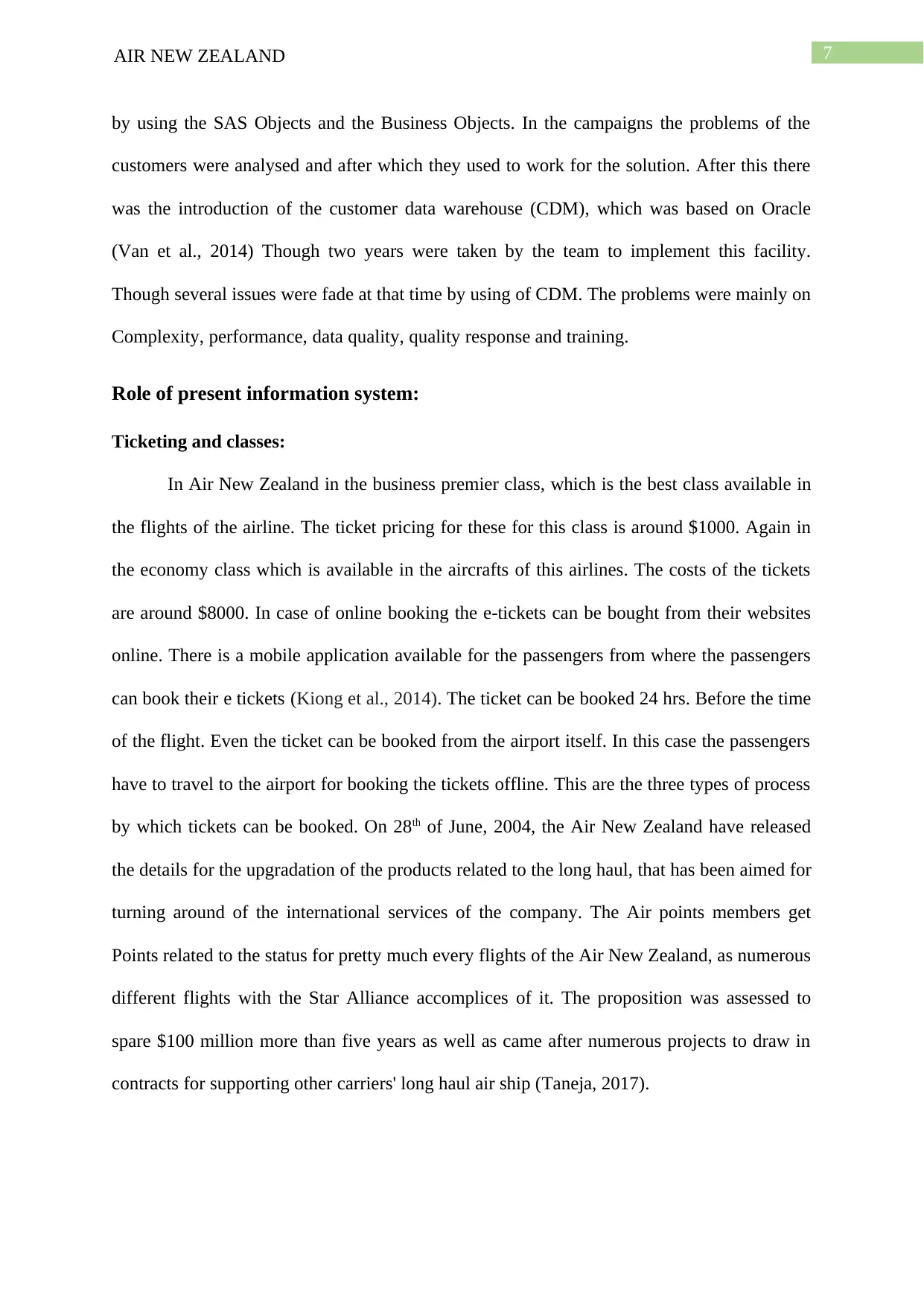
7AIR NEW ZEALAND
by using the SAS Objects and the Business Objects. In the campaigns the problems of the
customers were analysed and after which they used to work for the solution. After this there
was the introduction of the customer data warehouse (CDM), which was based on Oracle
(Van et al., 2014) Though two years were taken by the team to implement this facility.
Though several issues were fade at that time by using of CDM. The problems were mainly on
Complexity, performance, data quality, quality response and training.
Role of present information system:
Ticketing and classes:
In Air New Zealand in the business premier class, which is the best class available in
the flights of the airline. The ticket pricing for these for this class is around $1000. Again in
the economy class which is available in the aircrafts of this airlines. The costs of the tickets
are around $8000. In case of online booking the e-tickets can be bought from their websites
online. There is a mobile application available for the passengers from where the passengers
can book their e tickets (Kiong et al., 2014). The ticket can be booked 24 hrs. Before the time
of the flight. Even the ticket can be booked from the airport itself. In this case the passengers
have to travel to the airport for booking the tickets offline. This are the three types of process
by which tickets can be booked. On 28th of June, 2004, the Air New Zealand have released
the details for the upgradation of the products related to the long haul, that has been aimed for
turning around of the international services of the company. The Air points members get
Points related to the status for pretty much every flights of the Air New Zealand, as numerous
different flights with the Star Alliance accomplices of it. The proposition was assessed to
spare $100 million more than five years as well as came after numerous projects to draw in
contracts for supporting other carriers' long haul air ship (Taneja, 2017).
by using the SAS Objects and the Business Objects. In the campaigns the problems of the
customers were analysed and after which they used to work for the solution. After this there
was the introduction of the customer data warehouse (CDM), which was based on Oracle
(Van et al., 2014) Though two years were taken by the team to implement this facility.
Though several issues were fade at that time by using of CDM. The problems were mainly on
Complexity, performance, data quality, quality response and training.
Role of present information system:
Ticketing and classes:
In Air New Zealand in the business premier class, which is the best class available in
the flights of the airline. The ticket pricing for these for this class is around $1000. Again in
the economy class which is available in the aircrafts of this airlines. The costs of the tickets
are around $8000. In case of online booking the e-tickets can be bought from their websites
online. There is a mobile application available for the passengers from where the passengers
can book their e tickets (Kiong et al., 2014). The ticket can be booked 24 hrs. Before the time
of the flight. Even the ticket can be booked from the airport itself. In this case the passengers
have to travel to the airport for booking the tickets offline. This are the three types of process
by which tickets can be booked. On 28th of June, 2004, the Air New Zealand have released
the details for the upgradation of the products related to the long haul, that has been aimed for
turning around of the international services of the company. The Air points members get
Points related to the status for pretty much every flights of the Air New Zealand, as numerous
different flights with the Star Alliance accomplices of it. The proposition was assessed to
spare $100 million more than five years as well as came after numerous projects to draw in
contracts for supporting other carriers' long haul air ship (Taneja, 2017).
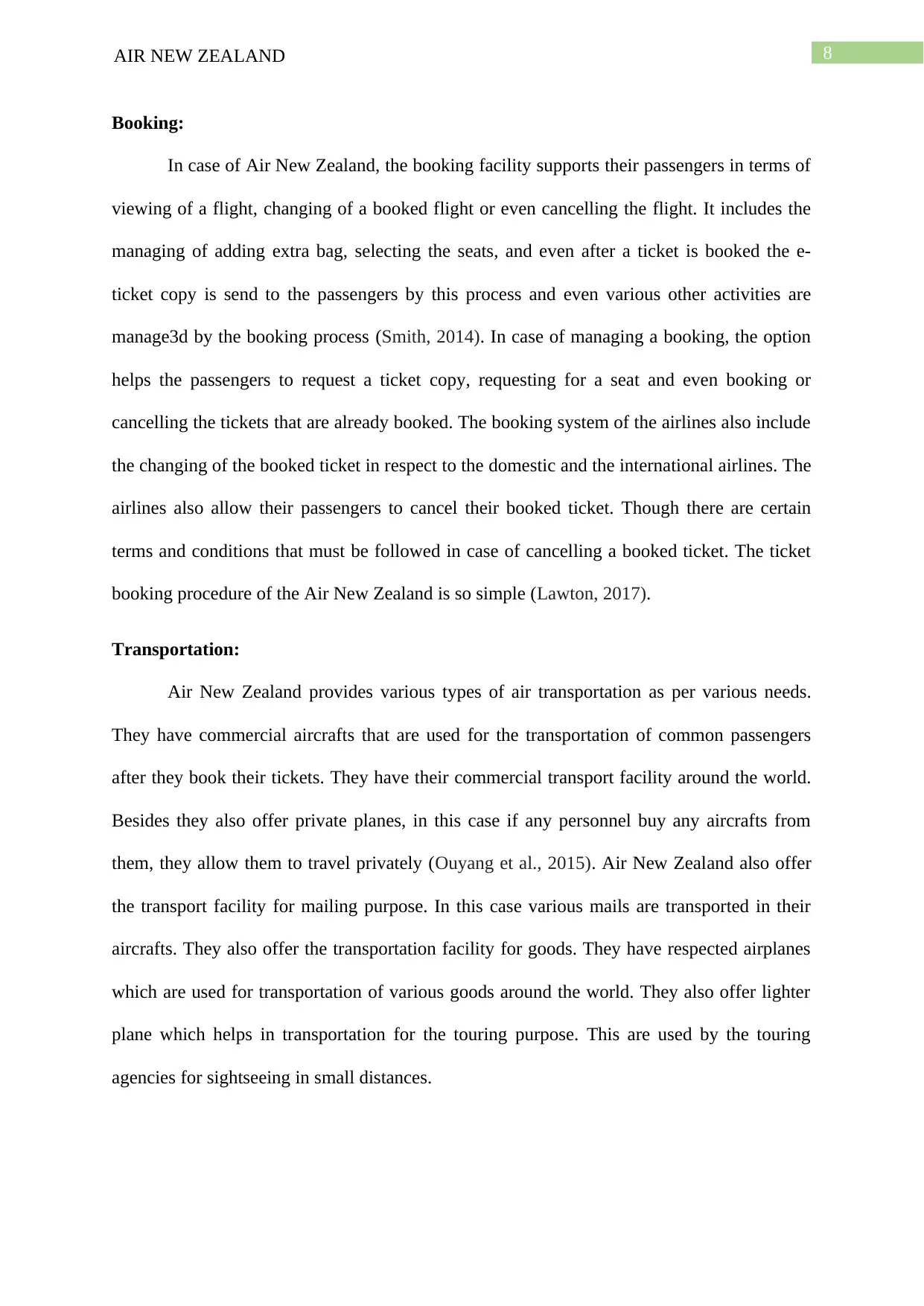
8AIR NEW ZEALAND
Booking:
In case of Air New Zealand, the booking facility supports their passengers in terms of
viewing of a flight, changing of a booked flight or even cancelling the flight. It includes the
managing of adding extra bag, selecting the seats, and even after a ticket is booked the e-
ticket copy is send to the passengers by this process and even various other activities are
manage3d by the booking process (Smith, 2014). In case of managing a booking, the option
helps the passengers to request a ticket copy, requesting for a seat and even booking or
cancelling the tickets that are already booked. The booking system of the airlines also include
the changing of the booked ticket in respect to the domestic and the international airlines. The
airlines also allow their passengers to cancel their booked ticket. Though there are certain
terms and conditions that must be followed in case of cancelling a booked ticket. The ticket
booking procedure of the Air New Zealand is so simple (Lawton, 2017).
Transportation:
Air New Zealand provides various types of air transportation as per various needs.
They have commercial aircrafts that are used for the transportation of common passengers
after they book their tickets. They have their commercial transport facility around the world.
Besides they also offer private planes, in this case if any personnel buy any aircrafts from
them, they allow them to travel privately (Ouyang et al., 2015). Air New Zealand also offer
the transport facility for mailing purpose. In this case various mails are transported in their
aircrafts. They also offer the transportation facility for goods. They have respected airplanes
which are used for transportation of various goods around the world. They also offer lighter
plane which helps in transportation for the touring purpose. This are used by the touring
agencies for sightseeing in small distances.
Booking:
In case of Air New Zealand, the booking facility supports their passengers in terms of
viewing of a flight, changing of a booked flight or even cancelling the flight. It includes the
managing of adding extra bag, selecting the seats, and even after a ticket is booked the e-
ticket copy is send to the passengers by this process and even various other activities are
manage3d by the booking process (Smith, 2014). In case of managing a booking, the option
helps the passengers to request a ticket copy, requesting for a seat and even booking or
cancelling the tickets that are already booked. The booking system of the airlines also include
the changing of the booked ticket in respect to the domestic and the international airlines. The
airlines also allow their passengers to cancel their booked ticket. Though there are certain
terms and conditions that must be followed in case of cancelling a booked ticket. The ticket
booking procedure of the Air New Zealand is so simple (Lawton, 2017).
Transportation:
Air New Zealand provides various types of air transportation as per various needs.
They have commercial aircrafts that are used for the transportation of common passengers
after they book their tickets. They have their commercial transport facility around the world.
Besides they also offer private planes, in this case if any personnel buy any aircrafts from
them, they allow them to travel privately (Ouyang et al., 2015). Air New Zealand also offer
the transport facility for mailing purpose. In this case various mails are transported in their
aircrafts. They also offer the transportation facility for goods. They have respected airplanes
which are used for transportation of various goods around the world. They also offer lighter
plane which helps in transportation for the touring purpose. This are used by the touring
agencies for sightseeing in small distances.
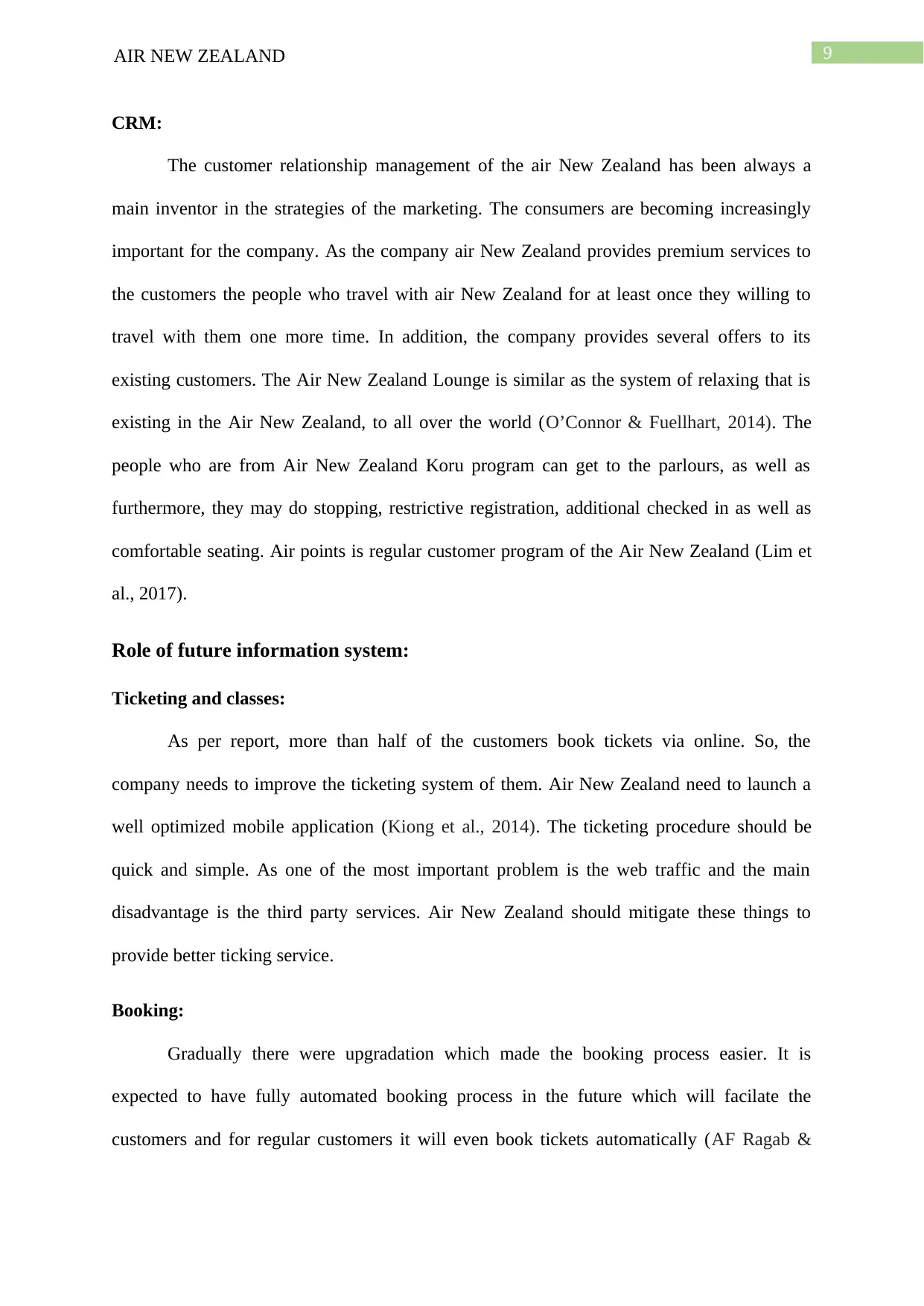
9AIR NEW ZEALAND
CRM:
The customer relationship management of the air New Zealand has been always a
main inventor in the strategies of the marketing. The consumers are becoming increasingly
important for the company. As the company air New Zealand provides premium services to
the customers the people who travel with air New Zealand for at least once they willing to
travel with them one more time. In addition, the company provides several offers to its
existing customers. The Air New Zealand Lounge is similar as the system of relaxing that is
existing in the Air New Zealand, to all over the world (O’Connor & Fuellhart, 2014). The
people who are from Air New Zealand Koru program can get to the parlours, as well as
furthermore, they may do stopping, restrictive registration, additional checked in as well as
comfortable seating. Air points is regular customer program of the Air New Zealand (Lim et
al., 2017).
Role of future information system:
Ticketing and classes:
As per report, more than half of the customers book tickets via online. So, the
company needs to improve the ticketing system of them. Air New Zealand need to launch a
well optimized mobile application (Kiong et al., 2014). The ticketing procedure should be
quick and simple. As one of the most important problem is the web traffic and the main
disadvantage is the third party services. Air New Zealand should mitigate these things to
provide better ticking service.
Booking:
Gradually there were upgradation which made the booking process easier. It is
expected to have fully automated booking process in the future which will facilate the
customers and for regular customers it will even book tickets automatically (AF Ragab &
CRM:
The customer relationship management of the air New Zealand has been always a
main inventor in the strategies of the marketing. The consumers are becoming increasingly
important for the company. As the company air New Zealand provides premium services to
the customers the people who travel with air New Zealand for at least once they willing to
travel with them one more time. In addition, the company provides several offers to its
existing customers. The Air New Zealand Lounge is similar as the system of relaxing that is
existing in the Air New Zealand, to all over the world (O’Connor & Fuellhart, 2014). The
people who are from Air New Zealand Koru program can get to the parlours, as well as
furthermore, they may do stopping, restrictive registration, additional checked in as well as
comfortable seating. Air points is regular customer program of the Air New Zealand (Lim et
al., 2017).
Role of future information system:
Ticketing and classes:
As per report, more than half of the customers book tickets via online. So, the
company needs to improve the ticketing system of them. Air New Zealand need to launch a
well optimized mobile application (Kiong et al., 2014). The ticketing procedure should be
quick and simple. As one of the most important problem is the web traffic and the main
disadvantage is the third party services. Air New Zealand should mitigate these things to
provide better ticking service.
Booking:
Gradually there were upgradation which made the booking process easier. It is
expected to have fully automated booking process in the future which will facilate the
customers and for regular customers it will even book tickets automatically (AF Ragab &
Secure Best Marks with AI Grader
Need help grading? Try our AI Grader for instant feedback on your assignments.
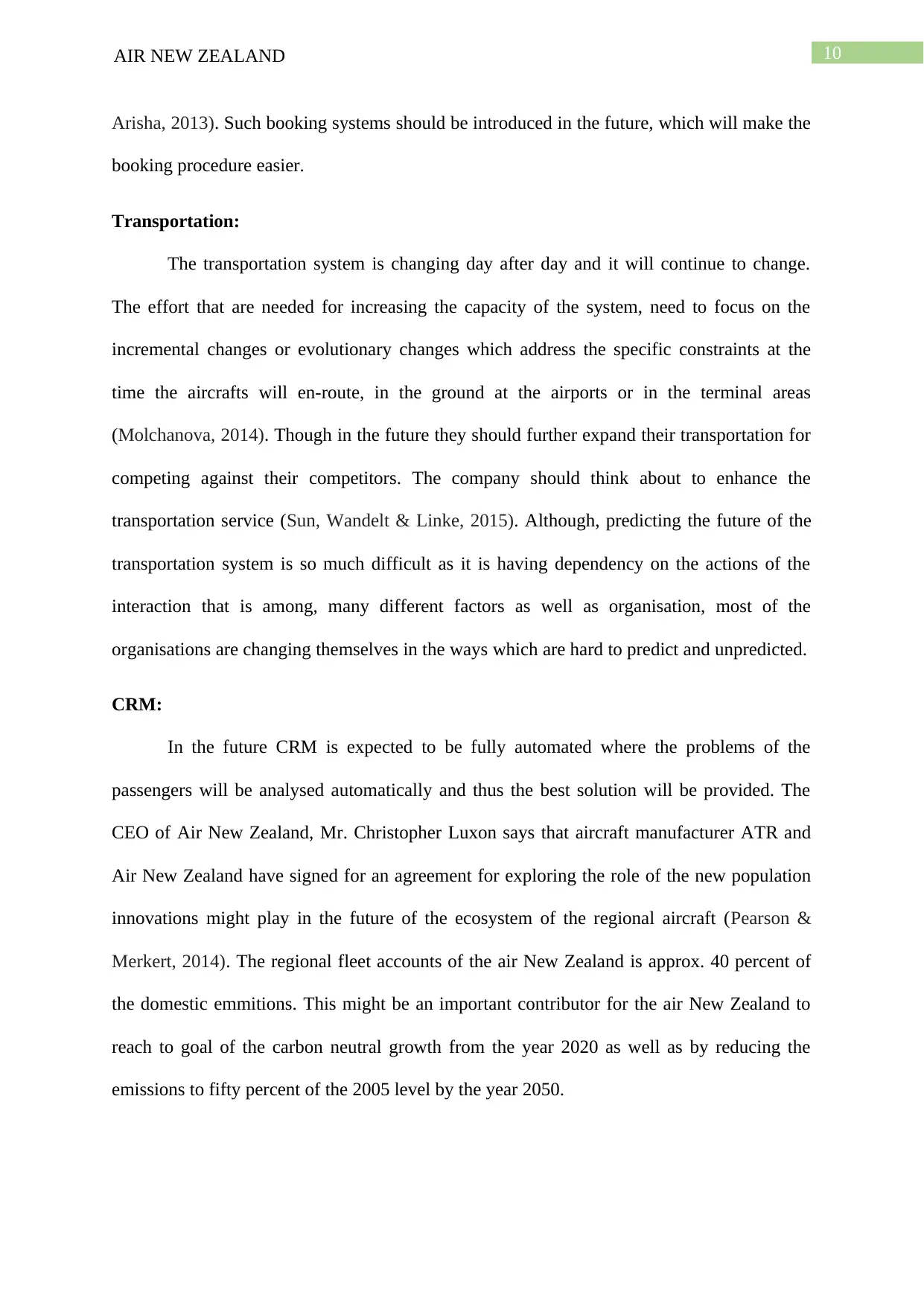
10AIR NEW ZEALAND
Arisha, 2013). Such booking systems should be introduced in the future, which will make the
booking procedure easier.
Transportation:
The transportation system is changing day after day and it will continue to change.
The effort that are needed for increasing the capacity of the system, need to focus on the
incremental changes or evolutionary changes which address the specific constraints at the
time the aircrafts will en-route, in the ground at the airports or in the terminal areas
(Molchanova, 2014). Though in the future they should further expand their transportation for
competing against their competitors. The company should think about to enhance the
transportation service (Sun, Wandelt & Linke, 2015). Although, predicting the future of the
transportation system is so much difficult as it is having dependency on the actions of the
interaction that is among, many different factors as well as organisation, most of the
organisations are changing themselves in the ways which are hard to predict and unpredicted.
CRM:
In the future CRM is expected to be fully automated where the problems of the
passengers will be analysed automatically and thus the best solution will be provided. The
CEO of Air New Zealand, Mr. Christopher Luxon says that aircraft manufacturer ATR and
Air New Zealand have signed for an agreement for exploring the role of the new population
innovations might play in the future of the ecosystem of the regional aircraft (Pearson &
Merkert, 2014). The regional fleet accounts of the air New Zealand is approx. 40 percent of
the domestic emmitions. This might be an important contributor for the air New Zealand to
reach to goal of the carbon neutral growth from the year 2020 as well as by reducing the
emissions to fifty percent of the 2005 level by the year 2050.
Arisha, 2013). Such booking systems should be introduced in the future, which will make the
booking procedure easier.
Transportation:
The transportation system is changing day after day and it will continue to change.
The effort that are needed for increasing the capacity of the system, need to focus on the
incremental changes or evolutionary changes which address the specific constraints at the
time the aircrafts will en-route, in the ground at the airports or in the terminal areas
(Molchanova, 2014). Though in the future they should further expand their transportation for
competing against their competitors. The company should think about to enhance the
transportation service (Sun, Wandelt & Linke, 2015). Although, predicting the future of the
transportation system is so much difficult as it is having dependency on the actions of the
interaction that is among, many different factors as well as organisation, most of the
organisations are changing themselves in the ways which are hard to predict and unpredicted.
CRM:
In the future CRM is expected to be fully automated where the problems of the
passengers will be analysed automatically and thus the best solution will be provided. The
CEO of Air New Zealand, Mr. Christopher Luxon says that aircraft manufacturer ATR and
Air New Zealand have signed for an agreement for exploring the role of the new population
innovations might play in the future of the ecosystem of the regional aircraft (Pearson &
Merkert, 2014). The regional fleet accounts of the air New Zealand is approx. 40 percent of
the domestic emmitions. This might be an important contributor for the air New Zealand to
reach to goal of the carbon neutral growth from the year 2020 as well as by reducing the
emissions to fifty percent of the 2005 level by the year 2050.
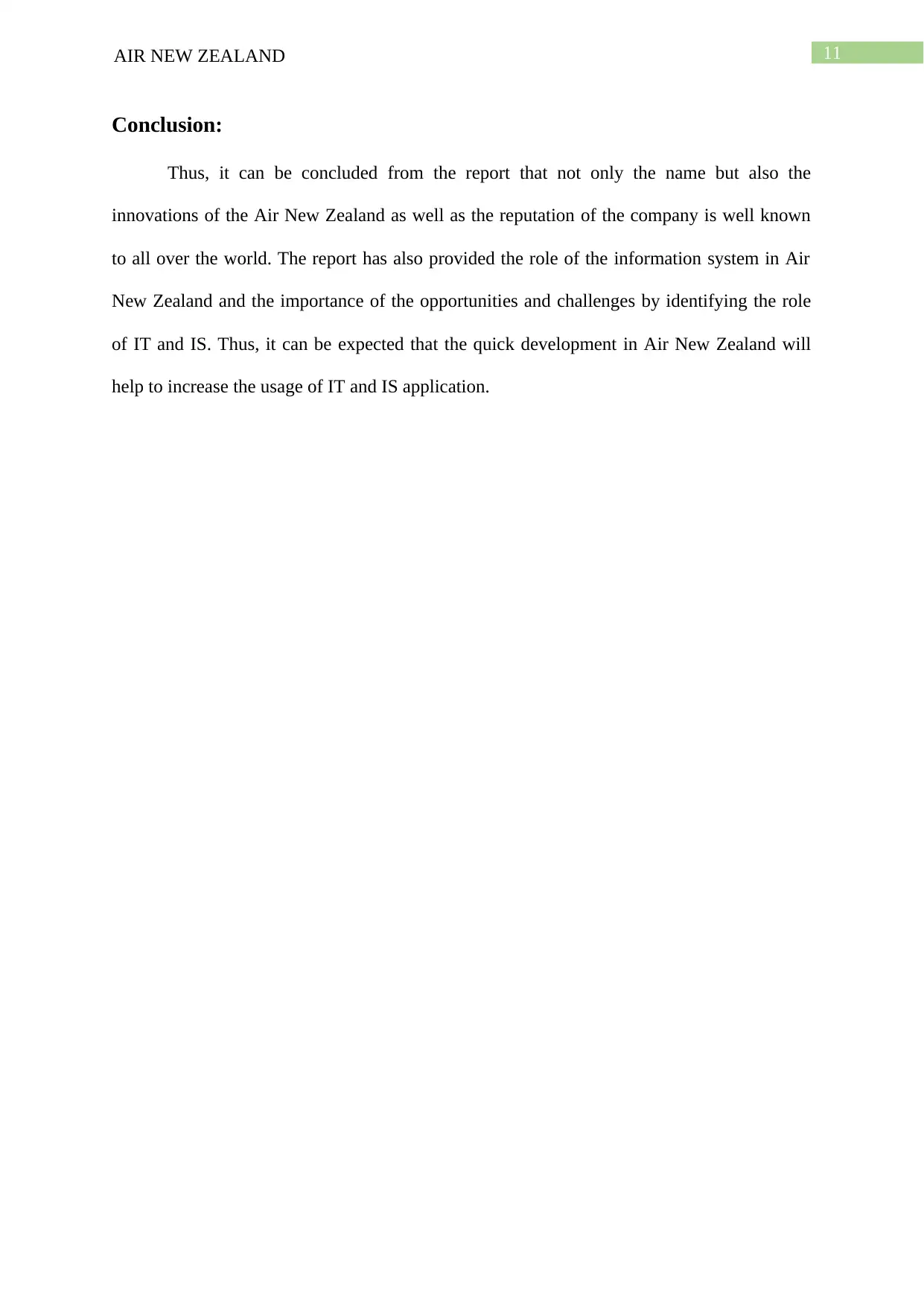
11AIR NEW ZEALAND
Conclusion:
Thus, it can be concluded from the report that not only the name but also the
innovations of the Air New Zealand as well as the reputation of the company is well known
to all over the world. The report has also provided the role of the information system in Air
New Zealand and the importance of the opportunities and challenges by identifying the role
of IT and IS. Thus, it can be expected that the quick development in Air New Zealand will
help to increase the usage of IT and IS application.
Conclusion:
Thus, it can be concluded from the report that not only the name but also the
innovations of the Air New Zealand as well as the reputation of the company is well known
to all over the world. The report has also provided the role of the information system in Air
New Zealand and the importance of the opportunities and challenges by identifying the role
of IT and IS. Thus, it can be expected that the quick development in Air New Zealand will
help to increase the usage of IT and IS application.
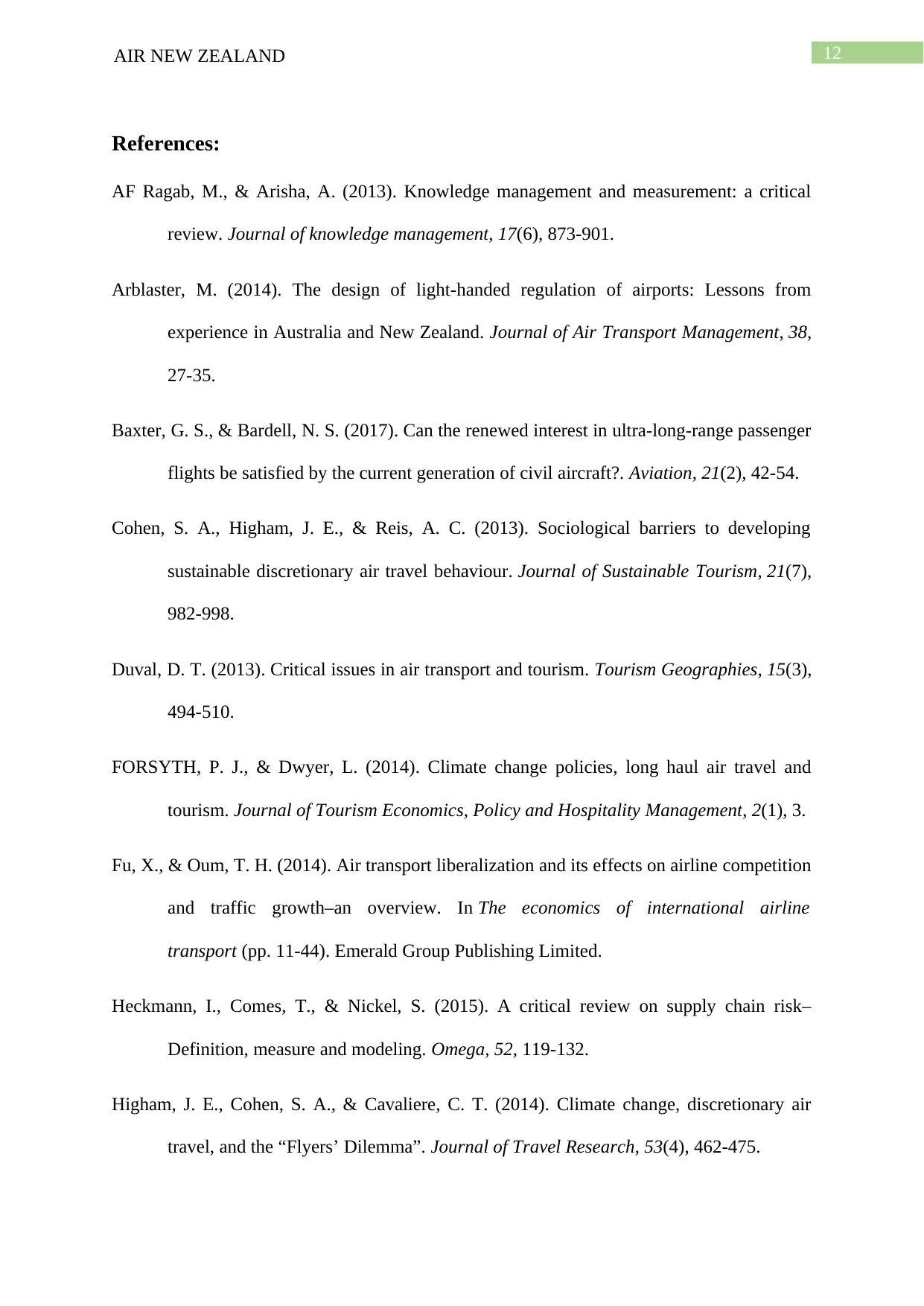
12AIR NEW ZEALAND
References:
AF Ragab, M., & Arisha, A. (2013). Knowledge management and measurement: a critical
review. Journal of knowledge management, 17(6), 873-901.
Arblaster, M. (2014). The design of light-handed regulation of airports: Lessons from
experience in Australia and New Zealand. Journal of Air Transport Management, 38,
27-35.
Baxter, G. S., & Bardell, N. S. (2017). Can the renewed interest in ultra-long-range passenger
flights be satisfied by the current generation of civil aircraft?. Aviation, 21(2), 42-54.
Cohen, S. A., Higham, J. E., & Reis, A. C. (2013). Sociological barriers to developing
sustainable discretionary air travel behaviour. Journal of Sustainable Tourism, 21(7),
982-998.
Duval, D. T. (2013). Critical issues in air transport and tourism. Tourism Geographies, 15(3),
494-510.
FORSYTH, P. J., & Dwyer, L. (2014). Climate change policies, long haul air travel and
tourism. Journal of Tourism Economics, Policy and Hospitality Management, 2(1), 3.
Fu, X., & Oum, T. H. (2014). Air transport liberalization and its effects on airline competition
and traffic growth–an overview. In The economics of international airline
transport (pp. 11-44). Emerald Group Publishing Limited.
Heckmann, I., Comes, T., & Nickel, S. (2015). A critical review on supply chain risk–
Definition, measure and modeling. Omega, 52, 119-132.
Higham, J. E., Cohen, S. A., & Cavaliere, C. T. (2014). Climate change, discretionary air
travel, and the “Flyers’ Dilemma”. Journal of Travel Research, 53(4), 462-475.
References:
AF Ragab, M., & Arisha, A. (2013). Knowledge management and measurement: a critical
review. Journal of knowledge management, 17(6), 873-901.
Arblaster, M. (2014). The design of light-handed regulation of airports: Lessons from
experience in Australia and New Zealand. Journal of Air Transport Management, 38,
27-35.
Baxter, G. S., & Bardell, N. S. (2017). Can the renewed interest in ultra-long-range passenger
flights be satisfied by the current generation of civil aircraft?. Aviation, 21(2), 42-54.
Cohen, S. A., Higham, J. E., & Reis, A. C. (2013). Sociological barriers to developing
sustainable discretionary air travel behaviour. Journal of Sustainable Tourism, 21(7),
982-998.
Duval, D. T. (2013). Critical issues in air transport and tourism. Tourism Geographies, 15(3),
494-510.
FORSYTH, P. J., & Dwyer, L. (2014). Climate change policies, long haul air travel and
tourism. Journal of Tourism Economics, Policy and Hospitality Management, 2(1), 3.
Fu, X., & Oum, T. H. (2014). Air transport liberalization and its effects on airline competition
and traffic growth–an overview. In The economics of international airline
transport (pp. 11-44). Emerald Group Publishing Limited.
Heckmann, I., Comes, T., & Nickel, S. (2015). A critical review on supply chain risk–
Definition, measure and modeling. Omega, 52, 119-132.
Higham, J. E., Cohen, S. A., & Cavaliere, C. T. (2014). Climate change, discretionary air
travel, and the “Flyers’ Dilemma”. Journal of Travel Research, 53(4), 462-475.
Paraphrase This Document
Need a fresh take? Get an instant paraphrase of this document with our AI Paraphraser
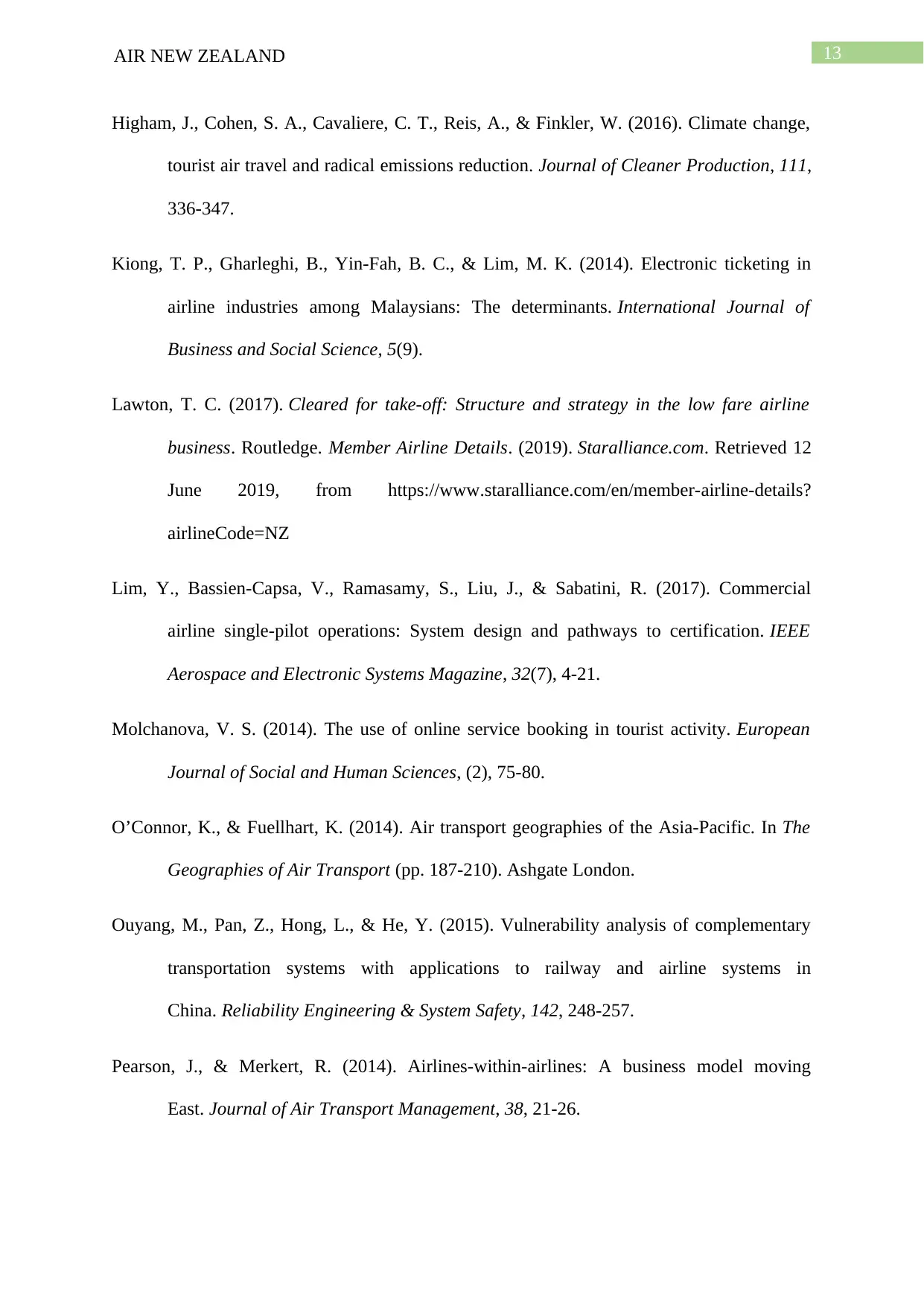
13AIR NEW ZEALAND
Higham, J., Cohen, S. A., Cavaliere, C. T., Reis, A., & Finkler, W. (2016). Climate change,
tourist air travel and radical emissions reduction. Journal of Cleaner Production, 111,
336-347.
Kiong, T. P., Gharleghi, B., Yin-Fah, B. C., & Lim, M. K. (2014). Electronic ticketing in
airline industries among Malaysians: The determinants. International Journal of
Business and Social Science, 5(9).
Lawton, T. C. (2017). Cleared for take-off: Structure and strategy in the low fare airline
business. Routledge. Member Airline Details. (2019). Staralliance.com. Retrieved 12
June 2019, from https://www.staralliance.com/en/member-airline-details?
airlineCode=NZ
Lim, Y., Bassien-Capsa, V., Ramasamy, S., Liu, J., & Sabatini, R. (2017). Commercial
airline single-pilot operations: System design and pathways to certification. IEEE
Aerospace and Electronic Systems Magazine, 32(7), 4-21.
Molchanova, V. S. (2014). The use of online service booking in tourist activity. European
Journal of Social and Human Sciences, (2), 75-80.
O’Connor, K., & Fuellhart, K. (2014). Air transport geographies of the Asia-Pacific. In The
Geographies of Air Transport (pp. 187-210). Ashgate London.
Ouyang, M., Pan, Z., Hong, L., & He, Y. (2015). Vulnerability analysis of complementary
transportation systems with applications to railway and airline systems in
China. Reliability Engineering & System Safety, 142, 248-257.
Pearson, J., & Merkert, R. (2014). Airlines-within-airlines: A business model moving
East. Journal of Air Transport Management, 38, 21-26.
Higham, J., Cohen, S. A., Cavaliere, C. T., Reis, A., & Finkler, W. (2016). Climate change,
tourist air travel and radical emissions reduction. Journal of Cleaner Production, 111,
336-347.
Kiong, T. P., Gharleghi, B., Yin-Fah, B. C., & Lim, M. K. (2014). Electronic ticketing in
airline industries among Malaysians: The determinants. International Journal of
Business and Social Science, 5(9).
Lawton, T. C. (2017). Cleared for take-off: Structure and strategy in the low fare airline
business. Routledge. Member Airline Details. (2019). Staralliance.com. Retrieved 12
June 2019, from https://www.staralliance.com/en/member-airline-details?
airlineCode=NZ
Lim, Y., Bassien-Capsa, V., Ramasamy, S., Liu, J., & Sabatini, R. (2017). Commercial
airline single-pilot operations: System design and pathways to certification. IEEE
Aerospace and Electronic Systems Magazine, 32(7), 4-21.
Molchanova, V. S. (2014). The use of online service booking in tourist activity. European
Journal of Social and Human Sciences, (2), 75-80.
O’Connor, K., & Fuellhart, K. (2014). Air transport geographies of the Asia-Pacific. In The
Geographies of Air Transport (pp. 187-210). Ashgate London.
Ouyang, M., Pan, Z., Hong, L., & He, Y. (2015). Vulnerability analysis of complementary
transportation systems with applications to railway and airline systems in
China. Reliability Engineering & System Safety, 142, 248-257.
Pearson, J., & Merkert, R. (2014). Airlines-within-airlines: A business model moving
East. Journal of Air Transport Management, 38, 21-26.
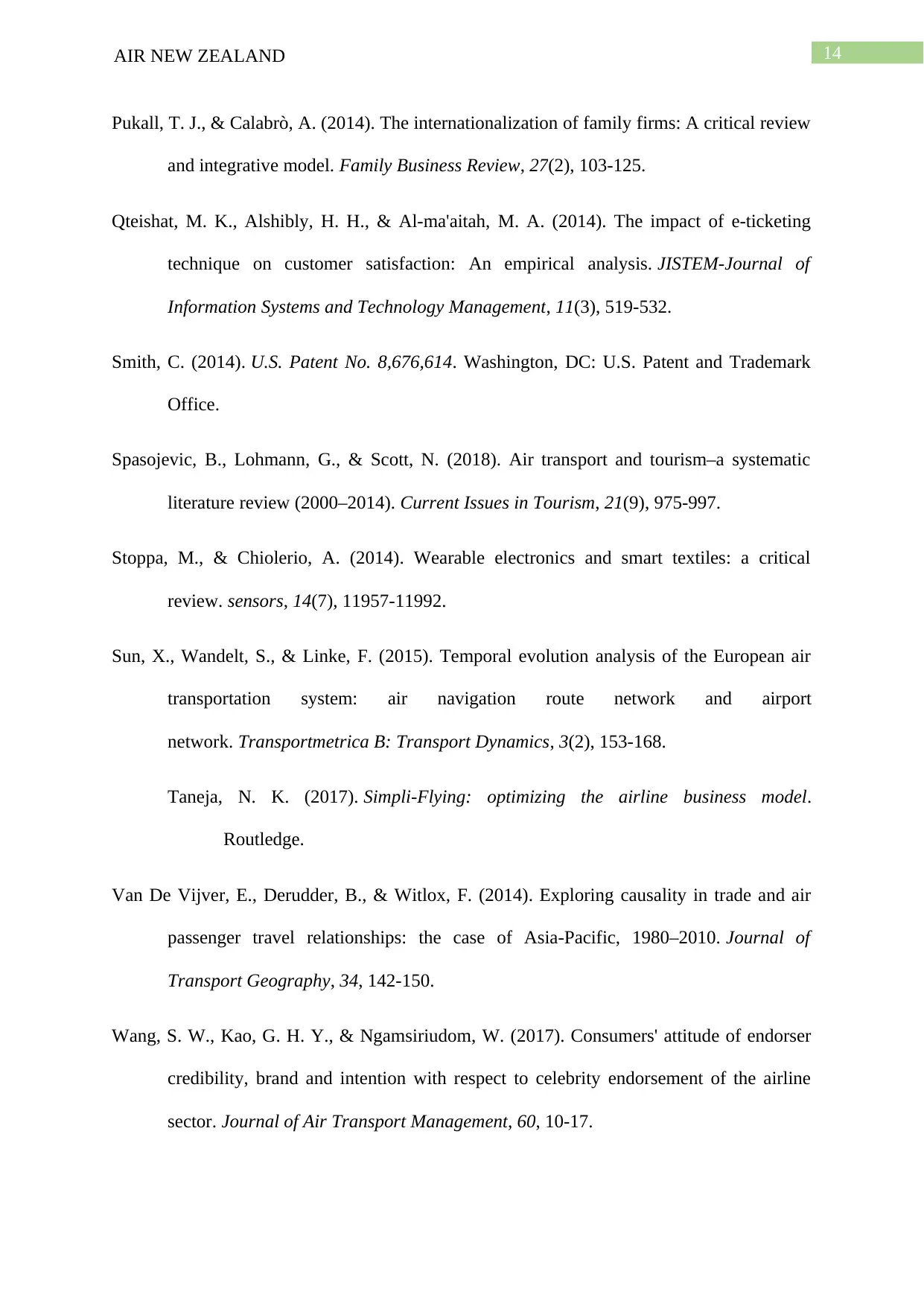
14AIR NEW ZEALAND
Pukall, T. J., & Calabrò, A. (2014). The internationalization of family firms: A critical review
and integrative model. Family Business Review, 27(2), 103-125.
Qteishat, M. K., Alshibly, H. H., & Al-ma'aitah, M. A. (2014). The impact of e-ticketing
technique on customer satisfaction: An empirical analysis. JISTEM-Journal of
Information Systems and Technology Management, 11(3), 519-532.
Smith, C. (2014). U.S. Patent No. 8,676,614. Washington, DC: U.S. Patent and Trademark
Office.
Spasojevic, B., Lohmann, G., & Scott, N. (2018). Air transport and tourism–a systematic
literature review (2000–2014). Current Issues in Tourism, 21(9), 975-997.
Stoppa, M., & Chiolerio, A. (2014). Wearable electronics and smart textiles: a critical
review. sensors, 14(7), 11957-11992.
Sun, X., Wandelt, S., & Linke, F. (2015). Temporal evolution analysis of the European air
transportation system: air navigation route network and airport
network. Transportmetrica B: Transport Dynamics, 3(2), 153-168.
Taneja, N. K. (2017). Simpli-Flying: optimizing the airline business model.
Routledge.
Van De Vijver, E., Derudder, B., & Witlox, F. (2014). Exploring causality in trade and air
passenger travel relationships: the case of Asia-Pacific, 1980–2010. Journal of
Transport Geography, 34, 142-150.
Wang, S. W., Kao, G. H. Y., & Ngamsiriudom, W. (2017). Consumers' attitude of endorser
credibility, brand and intention with respect to celebrity endorsement of the airline
sector. Journal of Air Transport Management, 60, 10-17.
Pukall, T. J., & Calabrò, A. (2014). The internationalization of family firms: A critical review
and integrative model. Family Business Review, 27(2), 103-125.
Qteishat, M. K., Alshibly, H. H., & Al-ma'aitah, M. A. (2014). The impact of e-ticketing
technique on customer satisfaction: An empirical analysis. JISTEM-Journal of
Information Systems and Technology Management, 11(3), 519-532.
Smith, C. (2014). U.S. Patent No. 8,676,614. Washington, DC: U.S. Patent and Trademark
Office.
Spasojevic, B., Lohmann, G., & Scott, N. (2018). Air transport and tourism–a systematic
literature review (2000–2014). Current Issues in Tourism, 21(9), 975-997.
Stoppa, M., & Chiolerio, A. (2014). Wearable electronics and smart textiles: a critical
review. sensors, 14(7), 11957-11992.
Sun, X., Wandelt, S., & Linke, F. (2015). Temporal evolution analysis of the European air
transportation system: air navigation route network and airport
network. Transportmetrica B: Transport Dynamics, 3(2), 153-168.
Taneja, N. K. (2017). Simpli-Flying: optimizing the airline business model.
Routledge.
Van De Vijver, E., Derudder, B., & Witlox, F. (2014). Exploring causality in trade and air
passenger travel relationships: the case of Asia-Pacific, 1980–2010. Journal of
Transport Geography, 34, 142-150.
Wang, S. W., Kao, G. H. Y., & Ngamsiriudom, W. (2017). Consumers' attitude of endorser
credibility, brand and intention with respect to celebrity endorsement of the airline
sector. Journal of Air Transport Management, 60, 10-17.
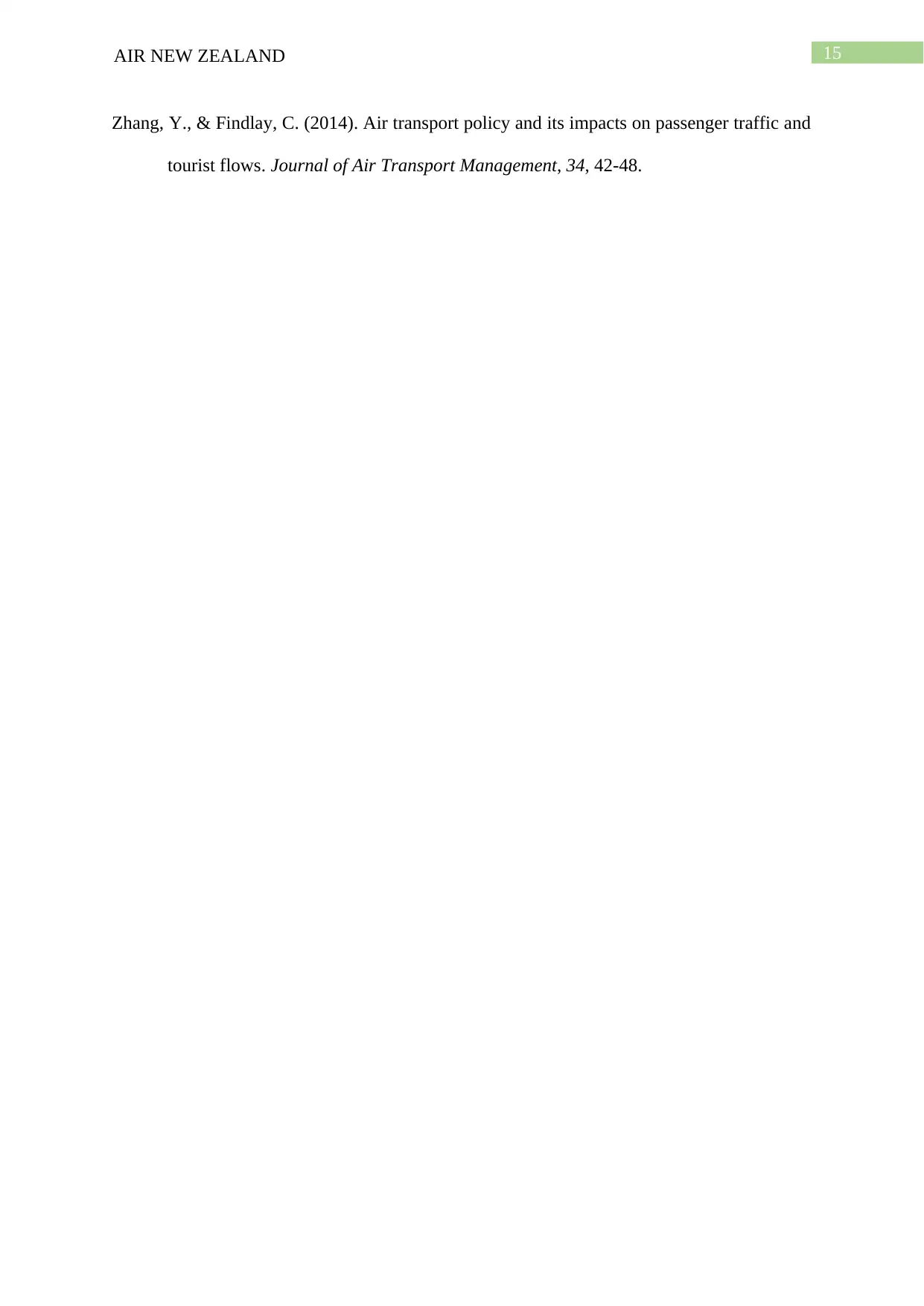
15AIR NEW ZEALAND
Zhang, Y., & Findlay, C. (2014). Air transport policy and its impacts on passenger traffic and
tourist flows. Journal of Air Transport Management, 34, 42-48.
Zhang, Y., & Findlay, C. (2014). Air transport policy and its impacts on passenger traffic and
tourist flows. Journal of Air Transport Management, 34, 42-48.
1 out of 16
Related Documents
Your All-in-One AI-Powered Toolkit for Academic Success.
+13062052269
info@desklib.com
Available 24*7 on WhatsApp / Email
![[object Object]](/_next/static/media/star-bottom.7253800d.svg)
Unlock your academic potential
© 2024 | Zucol Services PVT LTD | All rights reserved.





